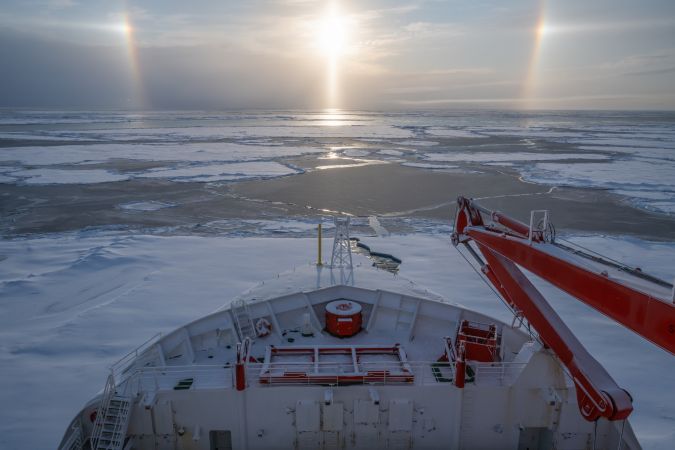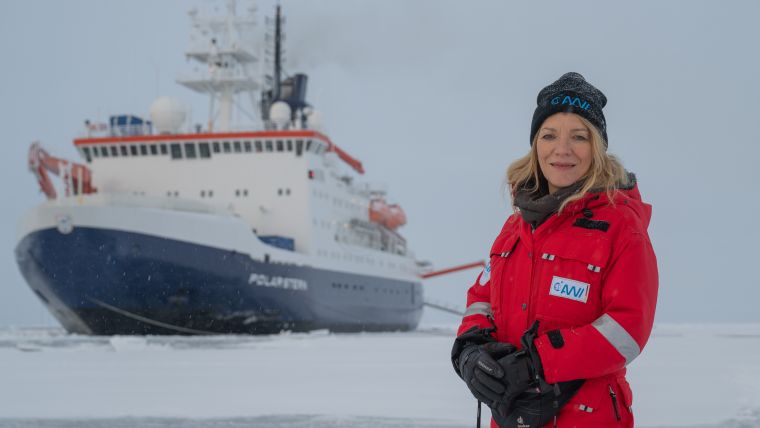Research vessel Polarstern returns to home port of Bremerhaven
After eventful and busy months, the Arctic season of the ArcWatch-1 Polarstern expedition ended this weekend. The team of almost 100 crew and scientists measured sea ice thickness and properties, recorded the currents and chemical properties of the ocean, and investigated life in and under the ice, in the open water and at the bottom of the deep sea. Their data shows significant changes compared to previous expeditions. On 7 September 2023, Polarstern reached the North Pole, and on 20 September the world’s first livestream of an ROV under-ice dive from the central Arctic took place.
2023 marked the globally hottest summer since weather records began. Glaciers melted faster than ever, huge forest fires in Canada and Siberia left their mark, and sea ice melted faster than previously observed in May and June. The expedition team therefore expected very little sea ice during its investigations in the central Arctic. However, initial results were surprising: the sea ice of the central Arctic Ocean did not melt as much as expected in August and September, and was even thicker than in previous years.
Under-ice robot monitoring
“The melt ponds, the sediment inclusions, the ice ridges – which are otherwise so characteristic of the Arctic sea ice landscape in summer – were missing. The ice was exceptionally flat and heavily melted from below. An unusual amount of snow on the floes ensured that they were protected from surface melt and there was little light directly under the ice,” stated sea ice physicist Dr Marcel Nicolaus of the Alfred Wegener Institute, Helmholtz Centre for Polar and Marine Research (AWI). He and his team used an underwater robot (ROV) at nine ice stations. A highlight of the expedition was the live broadcast of such a dive on the AWI YouTube channel on 20 September; the first ROV under-ice dive to be broadcast live from the central Arctic on the internet, followed by several hundred people.
The large-scale deployment of the EM-Bird, a sensor system deployed from the Polarstern helicopter, and parallel aircraft campaigns showed that the thickness of the sea ice was still 1.2 metres at the beginning of September – more than in the summer of the MOSAiC expedition in 2020 and the sea ice minimum in 2012. Thanks to real-time telecommunications via new satellites with polar coverage, the expedition’s data could be fed directly into models. Sea ice physicist Dr Thomas Krumpen explains the observed anomaly as follows: “In the last decades, the floes drifted mainly from the Siberian shelves into the Eurasian Basin, but this year and also last year the sea ice came from the Canadian Basin, without contact with the shallow shelf. This is a very unusual transpolar drift pattern.” The cause is probably a phenomenon of unusually stable low-pressure systems that held the ice together on the Siberian shelf over the summer and was linked to a supply of cold polar air.

Arctic life
“Accordingly, we found hardly any ice algae on the underside of the sea ice. In particular, Melosira arctica was missing, which can form metre-long chains and is an important nutrient supplier for the entire ecosystem. The ice looked rather dead this year. Due to the darkening by snow, algae floated up from the water and formed a film under the ice, to get some light,” reported chief scientist Prof. Antje Boetius, director of AWI. The physical oceanographers on board also discovered changes in the uppermost ocean layer, which was saltier than in previous years, due to the lack of ice melt and lower inputs of Siberian shelf water.
The comparison with the previous survey years 2012 and 2020 also showed differences in the planktonic life floating in the water. In August and September, the algal bloom was long gone, and no ice algal biomass had built up under the ice. Instead, the researchers found swarms of animals such as arrow worms, tunicates, ice amphipods, copepods, winged snails and comb jellies. The team led by the expedition co-leader Dr Christina Bienhold therefore found the biotic communities in the deep sea had changed: “Hardly any ice algae sank into the deep sea this year. Nevertheless, the overall activity of living organisms on the bottom increased somewhat compared to the sea ice minimum in 2012.” Images taken with a deep-sea camera showed that the composition of the community had changed substantially, with the once smooth seafloor heavily colonized and burrowed by annelids and bristle worms, crawling sea anemones and sea cucumbers. “It is amazing how quickly Arctic life responds to changes in sea ice cover,” said Prof. Boetius. The team was able to obtain samples of all size classes of life in the Arctic deep sea to study their diversity and distribution as well as changes compared to past decades.
The research of the ArcWatch-1 expedition also included seafloor mapping of previously unknown seamounts, one of which turned out to be a biodiversity hotspot. In addition, the chemists on board obtained large quantities of water and ice samples to record changes in the carbon pump to the deep sea and to detect non-degradable chemicals, as they are assessing the distribution of pollutants in the Arctic for a European project. The Polarstern team also successfully deployed a range of new high-tech instruments such as robots, autonomous sensors and sampling modules, and high-resolution under-ice cameras. Furthermore, they built a large network of buoys and deployed novel moorings for year-round surveys, to provide them with further data on changes in the central Arctic Ocean even after Polarstern leaves.
Interested parties can learn more about the expedition at the end of the year, when a documentary titled ArcWatch – Hoffnung im Eis will be broadcast in the Christmas programme of the German TV channel ARD and available in the ARD Mediathek. Polarstern will spend the next three weeks in the Lloyd Werft shipyard in Bremerhaven for standard maintenance and repair work before setting off for Antarctica at the end of October.

The ArcWatch-1 expedition in figures:
- Start: 3 August 2023 in Tromsø, Norway; end: 30 September 2023 in Bremerhaven, Germany.
- On board: 54 scientists and 43 crew members from 15 countries.
- Distance travelled: 5,311 nautical miles (9,836km), including 2,578 nautical miles (4,774km) through the ice in 48 days.
- Overflights for ice thickness measurements: 1,300km.
- Buoys deployed: 73 for meteorology, oceanography and sea ice physics for an international programme and two one-year moorings.
- Number of ice stations where researchers worked on the sea ice: 9.
- Ice dives with ROV Beast: 38 dives, over 50km total distance.
- Drilled ice cores: about 100.
- Number of newly discovered seamounts: 3.
- Area of newly mapped seafloor: 37,442km².
- Number of polar bear sightings: 3.
- Water samples collected: 11,808 litres of water.
- Number of net hauls: 55.
- Seafloor images: 8,970, a total of 35,880m² of seafloor photographed, at depths of 1,580–4,375m, and 30km of transects (with 200m width) surveyed with high-resolution sonar.
- Biological samples from the seafloor: 56 with the epibenthic sled and 250 with the box grab for meiofauna and macrofauna. 173 samples from the multicorer for meiofauna.
- Seafloor biogeochemistry: 196 cores from 20 deployments of the video-guided multigrab and 13 successful lander deployments (one did not return from the deep sea).
- Formation of a band: the ArcWatchers.
Participating institutions:
Alfred-Wegener-Institut, Helmholtz-Zentrum für Polar- und Meeresforschung
Albert-Ludwigs-Universität Freiburg
Dartmouth College
Deutscher Wetterdienst
Max-Planck-Institut für Marine Mikrobiologie
Otto-von-Guericke-Universität Magdeburg
Senckenberg Gesellschaft für Naturforschung
Universität Bremen
University of Colorado, Boulder
University of Exeter
University of Southern Denmark
University of Tasmania (UTAS)
University of Tokyo














